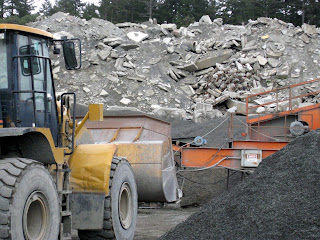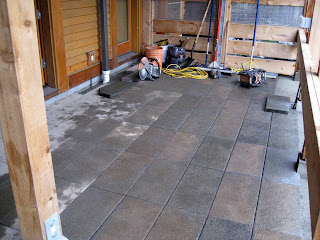The 'before' shot of the Gravel Bed Garden, before the Backyard Project got underway. A huge expanse of lawn that required care, so much water and it still looked a wreck.
October 2015
Tom at work painstakingly interlocking every rock to edge the boundary of the Gravel Bed Garden.
Sammy, Mat and Laura put in a french drain, laid drain cloth, added a layer of growing medium, and lastly placed the gravel.
April 2016
This garden is not going to be irrigated so I didn't have to wait for the irrigation installation before I could start planting. Early in the spring last year I started by transplanting rosemary bushes from other beds.
I started a trial path with different ground cover herbs to see which ones would be happy in the hot dry conditions.
Over the spring and summer, I planted samples of lots of different plants that fit my spec.
I marked the path out with empty pots which confused a lot of people - is that art?
August 2016
Plants have grown with only the occasional hand watering.
July 2017
The plants are thriving, having survived one hot dry summer and one cold wet winter.
Small Russian sage was planted early spring and by mid-summer had put down enough roots to support lots of flowers that the insects loved to visit.
Over this past spring and summer, I continued to buy and plant ground-cover herbs until the path was completed. Some plants aren't doing as well as others so next spring I may replant with hardier types.
Over the summer I often took my studio tea break sitting out in the Gravel Bed Garden so I kept an eye on how different plants were doing and when they needed help with a hand water.
October 2017
There was a lot of growth over the past summer.
The 2016 plantings have grown to make the path covered over in some areas. Other plants were pruned after flowering then continued to fill out.
The Corsican mint path plants in the foreground did not cope very well with the very dry summer and may be replaced next spring. The other plants have done so well I will be cut them back a lot next spring.
I have researched plants that fit a spec and made a long list of suitable candidates. After successfully trialling some of these plants over 2 springs and summers, I can now go ahead and complete the plantings as planned. Come spring I will be out visiting my favourite nurseries with plant list in hand.


























































